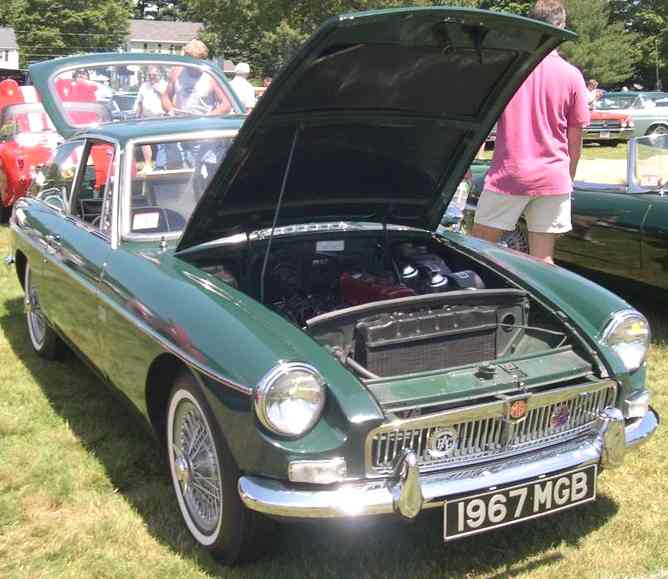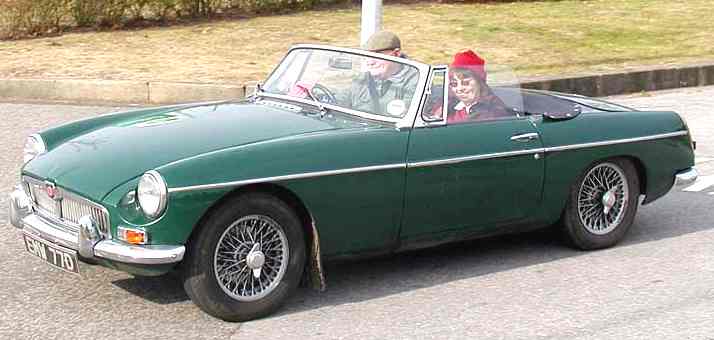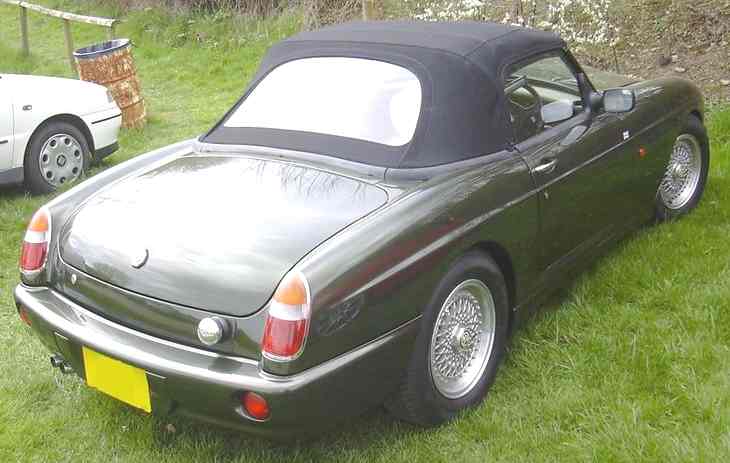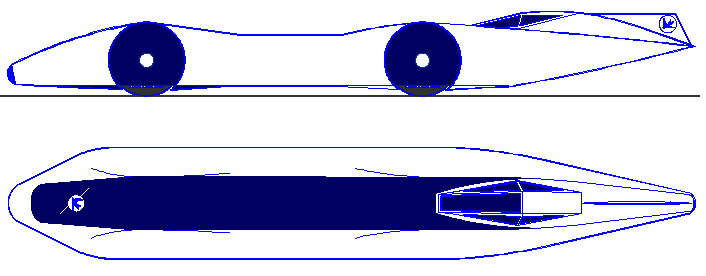|
MGB
|
||||||
|
HOME | AUTOMOTIVE | BLUEPLANET | ELECTRIC CARS | FORMULA E | ENERGY | INSURANCE | INDEX | SOLAR CARS |
||||||
|
The MGB was Britain's best-selling sports car. It was produced by the British Motor Corporation and sold under the MG marque. Available in both convertible and coupe ("GT") forms, it was launched in May of 1962 to replace the MGA, and produced until October 22, 1980. A later run of updated MGBs, the RV8, was produced in the 1990s.
MGB GT Coupe 1967
I've owned two of these splendid cars, one a wire wheel job (1987), the other a rostyle (1997). Both gave excellent service over several years, save for the usual petrol pump hastles. In addition to the reliable service, they were great fun to drive and own. Most MGB owners take great pride in their vehicles - I know I did.
The MGB was a relatively modern design at the time of its introduction. It utilized a unibody structure that reduced both weight and manufacturing costs as well as adding chassis strength. This was a considerable improvement in comparison to that of the traditional body-on-frame construction used on the MGA and T cars models as well as the MGB's rival, the Triumph TR series. The design included roll-up windows and a comfortable driver's compartment.
The MGB out-performed many of its more expensive rivals in both performance and handling when it was introduced. The MGB's performance was relatively brisk (for the period) with a 0 to 60 mph (100 km/h) time of just over 11 seconds, largely because of the relatively light weight of the car. The 3-bearing 1798 cc B-Series engine produced a 95 hp (71 kW) at 5400 rpm. The engine was upgraded in October 1964 to a five bearing crankshaft in an effort to enhance reliability. MGB's exported to the US, the majority of those produced, became less powerful than those available to rest of the World because of increasing emissions standards.
The MGB was one of the first cars to feature controlled crumple zones designed to protect the driver and passenger in a 30 mph (48 km/h) impact with an immovable barrier (200 ton).
Even today, running on tyres of the same generation, a 1962 MGB will corner better than a 2005 Ford Mustang, with a maximum turn rate of 0.96 g (9.4 m/s²) versus 0.85 g (8.3 m/s²) for the Ford Mustang.
MGB roadster
The roadster was the first of the MGB range to be produced. The body was a pure two-seater with no pretence at offering a rear seat; by making better use of space it was able to offer more passenger and luggage accommodation than the previous MGA while being 3 inches (75 mm) shorter overall. The suspension was also set to be softer, giving a smoother ride, and the larger engine gave a slightly higher top speed. Wheel diameter dropped from 15 to 14 inches.
Mk II
In late 1967, sufficient changes were introduced for the factory to define a Mk II model. Changes included synchromesh on all 4 gears with revised ratios, an optional BorgWarner automatic gearbox (except in the US), a new rear axle and an alternator in place of the dynamo previously used. To accommodate the new gearboxes there were significant changes to the sheet metal in the floorpan, and a new flat-topped transmission tunnel. US models got three windshield wipers instead of just two, and also received a plastic and foam rubber covered "safety" dashboard, dubbed the "Abingdon pillow". Other markets continued with the steel dash. Rubery Owen Rostyle wheels were introduced to replace the previous pressed steel versions in 1969 and reclining seats standardised in 1970. 1969 saw a new front grille, recessed, in black plastic. The traditional polished grille returned in 1972. 1970 saw split rear bumpers with the number plate in between, 1971 returned to the prior one-piece style.
Mk III
Further changes in 1972 brought about the Mk III. The main changes were to the interior with a new facia and improved heater.
In 1974, in order to meet US impact regulations, the chrome bumper overriders were replaced with large rubber ones. In 1975, a new front rubber bumper mounted to hydraulic cylinders incorporated the grille area as well, giving a minor restyling to the B's nose, and the rear bumper became rubber as well. The suspension was raised 1" to meet new US headlight height regulations. The much heavier bumpers and height change had a detrimental effect on handling and was only partly improved by revisions to the suspension geometry in 1977. US emissions regulations reduced horsepower, and by the time of the B's demise in 1980, performance was lackluster.
MGB soft top
GT
The fixed-roof MGB GT was introduced in 1965 sporting a Pininfarina-designed hatchback body. The new configuration was a 2+2 design. However, the new rear bench seat was of nominal use for most adults or older children. The engine and gearbox were the same as those used for the roadster. In fact, very few components differed between those used for the MGB roadster and the MGB GT. Acceleration of the GT was thus slightly lower than that of the roadster due to its increased weight, though some argue handling was actually improved by better weight distribution.
MGB GT V8
MG began offering the MGB GT V8 in 1973 utilizing the ubiquitous GM-developed POB aluminium 215 cu (3528 cc) Rover V8 engine, first fitted to the Rover P5B. These cars were similar to those already being produced by tuner Ken Costello. MG even contracted Costello to build the prototype MGB GT V8's. However, the powerful 180 bhp engine used by Costello for his conversions was replaced for production by MG with a modestly tuned version producing 137 bhp (102 kW). But 193 ft·lbf of torque helped it hit 60 mph in around 8 seconds, and go on to a respectable 125 mph top speed. The car was relatively expensive compared to its rivals at the time and production was low. Only GT versions were produced by the factory with production ending in 1976. The MGB GT V8 was not officially exported to the United States making the cars even more rare in the U.S. than in the U.K.
MGC
The MGC was a 2912 cc, straight-6 version of the MGB sold in the late 1960s and given the code ADO52. It was also intended as a replacement for the Austin-Healey 3000 which would have been ADO51 but this never got beyond the design proposal stage. The first engine to be considered was an Australian-designed six cylinder version of the BMC B-Series but the production versions used the Morris Engines designed C-Series that was also to be used for the new Austin 3-Litre 4-Door saloon. In the twin SU carburettor form used in the MGC the engine produced 145 bhp at 5250 rpm. The body shell had to have considerable revisions around the engine bay and to the floor pan, but externally the only differences were a distinctive bonnet bulge to accommodate the relocated radiator, and a teardrop for carburettor clearance. It got different brakes from the MGB, 15 inch wheels, a lower geared rack and pinion and special torsion bar suspension with telescopic dampers. Like the MGB, it was available as a coupé (GT) and roadster. A three speed automatic gearbox was available as an option. The car was capable of reaching a top speed of 120 mph (193 km/h).
The heavy engine (209 pounds heavier than the 1798 cc MGB engine) changed the vehicle's handling, and it got a mixed press response. The MGC was cancelled in 1969 after less than two years of production.
MG RV8 - TVR like!
RV8
Interest in small roadsters increased in the 1990s following the introduction of the Mazda MX-5, and MG (now owned by Rover Group) capitalized on this by producing updated parts and body panels for the original MGB cars. In 1992, the company used these parts to introduce a new updated version of the old car. The suspension was only slightly updated, sharing the old leaf sprung rear of the MGB. The bonnet, boot lid, and doors were shared with the original car, as were the rear drum brakes. However, the engine was the respected aluminum Rover V8, previously used in the MGB GT V8. A limited-slip differential was also fitted.
Performance was good, with 190 bhp (142 kW) at 4,750 rpm and 0 to 60 mph (100 km/h) acceleration of 5.9 s. Largely due to the rear drum brakes and rear leaf springs (perceived to be too old fashioned for a modern performance car), the RV8 was not popular with road testers at the time. However, this did not prevent the RV8 from being a moderate sales success and paved the way for the introduction of the modern MGF a few years later.
It also capitalized on an interest in British products in Japan. A sizeable chunk of MG RV8 production went to that country. Achieved overall or class wins
The MGB was highly successful in international road competition events such as the Monte Carlo Rally when in 1964 it won the GT category, Sebring, the Spa 1000 kilometre and the 1963, 1964 and 1965 Le Mans 24 hour beating more powerful expensive cars regularly.
LINKS and REFERENCE
Please click on the links above to find out about these famous automotive makers. If your company is not included and you would like to be listed, please let us know.
UK VEHICLE INSURANCE ONLINE A - Z
No matter what car, van or bike you drive, we're all looking for great value and quality in our UK motor insurance? But who is the best - who is the cheapest and who offers the great service in the event of a claim?
See the insurance companies below who claim to offer competitive cover at sensible prices, our guide to the jargon and tips for cutting your quote - Good Luck:-
A taste for adventure capitalists
The world's fastest electric car: 350mph + using energy from nature
|
||||||
|
BLUEPLANET BE3 | EDUCATION | ELECTRIC CYCLES | SOLARNAVIGATOR |
||||||
|
The
content of this website is copyright © 1991 and 2013 Electrick
Publications. All rights reserved. The bluebird logo |



